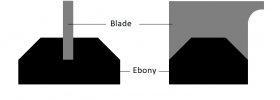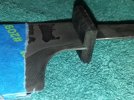weo
Basic Member
- Joined
- Sep 21, 2014
- Messages
- 3,069
Hello again, all. I'm looking to do something like this in ebony for some kitchen knives.

I don't have a milling machine, so could I use a drill press to mill out the slot in the ebony?
When reading the description of the end mills at McMaster Carr, they mention that:
"Their extreme hardness means they are brittle, so a highly rigid setup, such as a CNC machine, is necessary to prevent the end mill from breaking."
Because I'm using these for wood and not metal, is this still a concern?
Oh, and I'm looking at a 0.055" slot.
Thanks and stay safe

I don't have a milling machine, so could I use a drill press to mill out the slot in the ebony?
When reading the description of the end mills at McMaster Carr, they mention that:
"Their extreme hardness means they are brittle, so a highly rigid setup, such as a CNC machine, is necessary to prevent the end mill from breaking."
Because I'm using these for wood and not metal, is this still a concern?
Oh, and I'm looking at a 0.055" slot.
Thanks and stay safe




